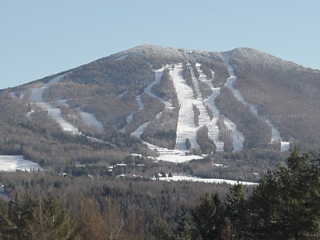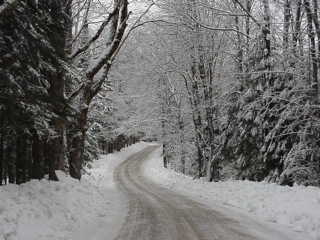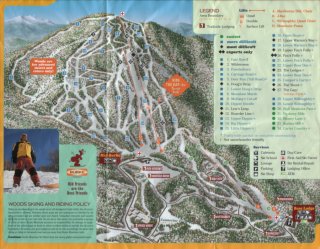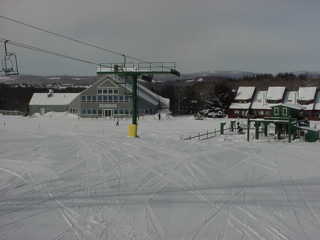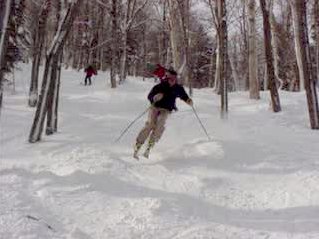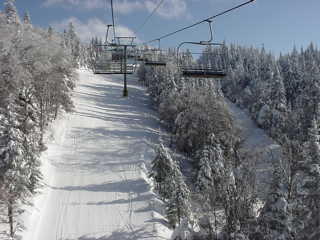East Burke, VT – Up on the mountain, several
different sets of slalom gates were drilled into the base depths coating Warren’s
Way. Coaches stood by observing racers who lined up atop each course before
slapping each breakaway gate with a resounding thwack. Down at the
Mid-Burke lodge, still other gate runners were warming up in the radiant heat
of a wood pellet stove as hats and gloves hung to dry, or by sipping hot chocolate
from Styrofoam cups.
n
|
Burke Mountain
Bucolic scenes like this snow-covered country road abound in Vermont’s Click image to open a full-size trail map
Burke’s Sherburne Base Lodge.
|
Such scenes are a way of life at Burke Mountain, tucked into
the nether reaches of Vermont’s pastoral Northeast Kingdom. Now operated
by a business offshoot of ski racing’s fabled Burke Mountain Academy, Burke
Mountain plays a unique role in the local community: recreational asset, racer
training ground, local physical education accessory, and vacation destination,
all rolled into one.
SAVED FROM EXTINCTION
Burke Mountain Academy was founded in 1970 by prototypical coach
and ski guru Warren Witherell, who had already established a permanent coaching
clinic at Burke. A nearby farmhouse provided dormitory space to allow Witherell
to transform his clinic into the nation’s first ski racing academy, a revolutionary
concept in a country where race training had primarily been a weekend endeavor.
The concept was remarkably successful, both academically and athletically.
Within two years, ten racers from the Academy had earned berths on the U.S.
Ski Team, and no fewer than 36 Olympians have graduated from the Burke Mountain
Academy’s program over the past three decades, including current U.S. Ski
Team star Erik Schlopy.
Burke Mountain Academy, of course, has always been tied to its
namesake ski area. Such a development program naturally requires ski lifts
and trails within close proximity. The resort, however, foundered through
a series of undercapitalized investors. When the most recent one failed,
and the resort was sold at auction to a bidder who planned to liquidate the
mountain’s assets, BMA formed a limited liability corporation that stepped
forward to purchase the assets in 2000 for a paltry $470,000. Neighbors banded
together to organize a homespun season pass sales campaign that sold the tickets
in record numbers. Nearby Jay Peak Resort upped the ante with a donation
that extended the season passes to cover Jay’s lifts as well. The limited
liability corporation then leased the mountain to the newly formed Burke Mountain
Operating Company to open the resort in time for the 2000-2001 season.
The Academy’s development programs are now assured, as they
no longer have to wait for the next investor’s other shoe to drop.
A DIFFERENT WAY OF LIFE
Things happen slowly in Vermont’s Northeast Kingdom, the state’s
largest and least-populated region. Christened with the name over 50 years
ago by Vermont State Senator George Aiken for its beauty and independent spirit,
the Kingdom is seemingly miles from anywhere, yet Interstate highway development
in northern New England has placed the region surprisingly close to major
northeastern population centers such as Montréal (2½ hours), Boston (3 to
3½ hours), and New York City (6 hours). Despite the highway proximity, however,
the Kingdom is another world altogether.
Drive north from St. Johnsbury, the region’s largest city with
only 7,571 residents and the area’s only light industry, and the landscape
quickly transforms to a mixture of wooded hills, patchwork farmland, and winding
unpaved country roads before disappearing into a wilderness of mountains and
lakes stretching to the Canadian border. It’s a place where simple qualities
are still important, where neighbors still depend upon neighbors, where creative
solutions solve vexing problems, and where conversations between friends are
still born at the local general store. It’s a place where, in many ways,
time has stood still for the past 30 years.
Right at the transition between farmland and wilderness lays
Burke Mountain, a monadnock rising from the surrounding lowlands. Like the
Kingdom’s inhabitants, Burke remains independent, resourceful, and full of
character.
Boasting a respectable 2,000 vertical feet of lift-served skiing
and riding, the terrain on Burke Mountain is primarily separated into two
independent yet connected pods. Visitors arrive first at the Base Lodge below
the Sherburne trails, a collection of gentle novice trails actually below
the mountain’s original base that wind past small groupings of slopeside condominiums.
From the top of the Sherburne Double Chair, hang a quick left and you almost
immediately arrive at the Mid-Burke Lodge, an older structure with more limited
services at the base of the mountain proper. (Intermediate and advanced skiers
lacking the need to rent equipment or schedule lessons, and content with bypassing
the more spacious Base Lodge, may drive directly past the summer summit toll
road to Mid-Burke via a potholed access road.)
A base-to-summit fixed grip quad chair and a poma surface lift
used primarily by BMA racers both rise above the Mid-Burke lodge. From the
mountain’s wooded summit, commanding views reach Sugarbush and Mt. Mansfield
to the west, Jay Peak to the northwest, and the striking topography of the
Northeast Kingdom’s Willoughby Gap immediately to the north.
Although nearly deserted on a Wednesday morning, I boarded the
quad with Tim Daley, a typically friendly longtime Kingdom resident. He was
irrepressibly enthusiastic about Burke. "I love the reactions I get from
skiers after they ski here," he bubbled.
Rather than parting ways upon reaching the summit, we instead
stayed together to share some runs. Giant slalom cruisers like Doug’s Drop
and Willoughby stick to the fall line on the mountain’s front side, yet tumble
and fall with the same character that still blesses the Northeast Kingdom.
Other cruisers, like the succession of Dippers (Upper Dipper, Big Dipper,
and Little Dipper) that work their way around toward the mountain’s eastern
shoulder, are worthy of the mountain’s nickname “Vermont’s Northern Star.”
By contrast, other routes of descent come standard with a sense
of adventure. Following a brief traverse across the mountain’s summit, East
Bowl sits by itself on the resort’s eastern perimeter, a classic trail in
the traditional New England sense. Narrow and convoluted, it follows the
road less traveled as it rolls and dives toward the Mid-Burke base. Deserted
and begging for speed, the roller-coaster ride ends with a long up-and-down
traverse back to the lifts that would likely frustrate many a snowboarder.
|
Enjoying Burke’s glades. |
Look back uphill on the traverse out of East Bowl, and you’ll
spot tracks spilling out of the northern hardwood forest, for this is the
domain of Burke’s glades. Some marked with trail signs at the entrance, others
not, Burke has carved a surprising amount of wooded terrain from the mountain
forest. Painted on the trail map but unnamed and unnumbered, these woods
runs descend the mountain in a series of steps. Like Burke’s trails themselves,
the glades still follow the natural contours of an eminently interesting mountain.
Burke may be a mid-sized mountain, but these routes were as long as my screaming
thighs would permit.
A UNIQUE SOLUTION
Returning to the Base Lodge for a bite to eat, I could barely
find floor space to scout out an empty seat. The rugrats were everywhere.
Some were dressed for the elements by a few adults, each of whom severely
overtaxed for their attention, while others battled a couple of video games.
It was as if Burke had been invaded by an entire elementary school district.
Which, in fact, is just what had happened. Burke’s importance
to the community is reinforced by its commitment to local youth. Over 1,200
local school children ski and ride Burke’s slopes each week at subsidized
$7 rates including rentals and lessons. Many kids in the economically challenged
Northeast Kingdom who might otherwise not be able to are given the opportunity
to learn a life-long sport and enjoyment of the winter outdoors.
Running a ski resort and maintaining programs such as these
costs money, and Burke Mountain Academy realizes that it can’t do it alone.
In stereotypical Northeast Kingdom fashion, residents are banding together
to create a unique, innovative and resourceful solution by forming Friends
of Burke Mountain.
|
ONLINE VIDEO View 45th Parallel, a First Tracks!! Online exclusive. In much of
|
|||
IF YOU GO …The Roof: Studio through Twenty minutes further afield, several hotels in The Eats: The Northeast Kingdom’s independent The Diversions: The Kingdom is a rural region, The Options: Alpine skiing and snowboarding
Near Burke Mountain’s summit. |
By purchasing the ski resort, the Academy found itself facing
potential losses on ski operations every year to benefit not only themselves,
but also condominium property owners, local businesses dependent upon visitors,
and the skiers of Burke as well. Lacking both the funds and the desire to
develop and market Burke Mountain to the masses, Friends of Burke Mountain
was founded in early 2002 by the Academy and several members of the Burke,
Lyndon, St. Johnsbury, and other area communities to address the challenge
of keeping Burke Mountain in operation and accessible as a recreation center
to children of all ages throughout the Northeast Kingdom. In the words of
Friends of Burke Mountain, “BMA now feels that the original ideal of stabilizing
the mountain’s operations and then selling it to a developer would probably
put BMA and the community right back in the same situation that we all have
historically experienced. We need to join together to do it ourselves.”
The Friends of Burke Mountain vision is that “the mountain will
maintain and, in a limited way, try to build its commercial ski operations
in order to help fund its mission, but it will not attempt a large-scale commercial
development program.” Lacking the capital to fund an aggressive marketing
campaign, the grassroots plan is to depend heavily on friends and supporters
of BMA and on the local community to drive sales of season passes, corporate
gold passes, block tickets, and other programs to help the mountain approach
the break-even point annually. The Academy will continue to lease the current
ski area assets to the Operating Company and continue to puchase ski passes
for staff and students, as well as pledge an annual cash contribution toward
any anticipated deficit. It also hopes that other area schools and nearby
Lyndon State College, the curriculum of which includes a Ski Area Management
degree program, will likewise contribute funds and purchase passes. Meanwhile,
the Burke Mountain Operating Company has pledged to place any net operating
profits into a fund dedicated to support future operations. Finally, Friends
of Burke Mountain has formed a not-for-profit Burke Recreational and Education
Fund to initiate a local fundraising campaign to help subsidize the $7 schoolchildren
program, and to seek a Vermont state Block Grant or other low-cost funding
source to help promote jobs in their portion of the Northeast Kingdom.
It’s an ambitious, resourceful, and innovative plan – exactly
what you’d expect from the people of the Northeast Kingdom.

